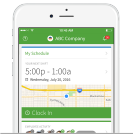How to schedule your employees when customer demand is uncertain
Try When I Work for free
As America reopens, businesses are figuring out how to adapt to new norms, welcome back employees, and re-engage customers, but what will also be challenging is forecasting customer demand. As society figures out its comfort level reengaging with restaurants, retailers, and other establishments demand will surely fluctuate differently than before.
When customer demand is uncertain, planning and scheduling employees can be near impossible, or a crapshoot at best. One way businesses have adapted to uncertain market conditions is by switching to flexible self-scheduling. In fact, in some states, retailers, and restaurants have increased their use of self-scheduling by 10x since early March.
What is self-scheduling? Flexible self-scheduling is the term used when a manager defines scheduling needs based on demand, but allows employees to select, trade, and fill shifts themselves. Allowing schedules to be created faster, with less effort, and gives hourly employees more control over their work life. Self-scheduling isn’t new and is often heralded as the future of work and key to driving better outcomes for employers and more engaged employees.
Getting started with self-scheduling
The first step to self-scheduling is to determine how many shifts you need in each position based on the demand you are expecting. When demand is uncertain, you may want to establish minimal or essential shift coverage. Even if you’re planning for minimal coverage, it’s still a good idea to plan at least a week out so your coverage is stable and employees have some lead time to select and confirm coverage of the shifts.
Communicating with your team
Once you’ve confirmed essential shift coverage with your employees, let them know that if demand picks up during the week you will notify them about additional shifts they can pick up in addition to what they’ve already confirmed. If you use a mobile employee scheduling software that supports self-scheduling, getting additional shifts filled can happen very fast, and in many cases shifts can be filled within an hour of notifying your team.
Managing self-scheduling manually can be challenging and slow, but one of the most effective ways to implement self-scheduling is to use employee scheduling software that enables managers to post shifts that need to be covered, and allow employees to pick them up in a self-service manner from their mobile phone.
Self-scheduling makes it easier to flexibly fill shifts based on near-term needs, and quickly increase or decrease capacity when customer demand is uncertain. For businesses adapting to new models like delivery or curbside pickup, self-scheduling can be an effective way to support these new and legacy business models.
Start your free 14-day trial of When I Work! Click here to start scheduling your employees today.







